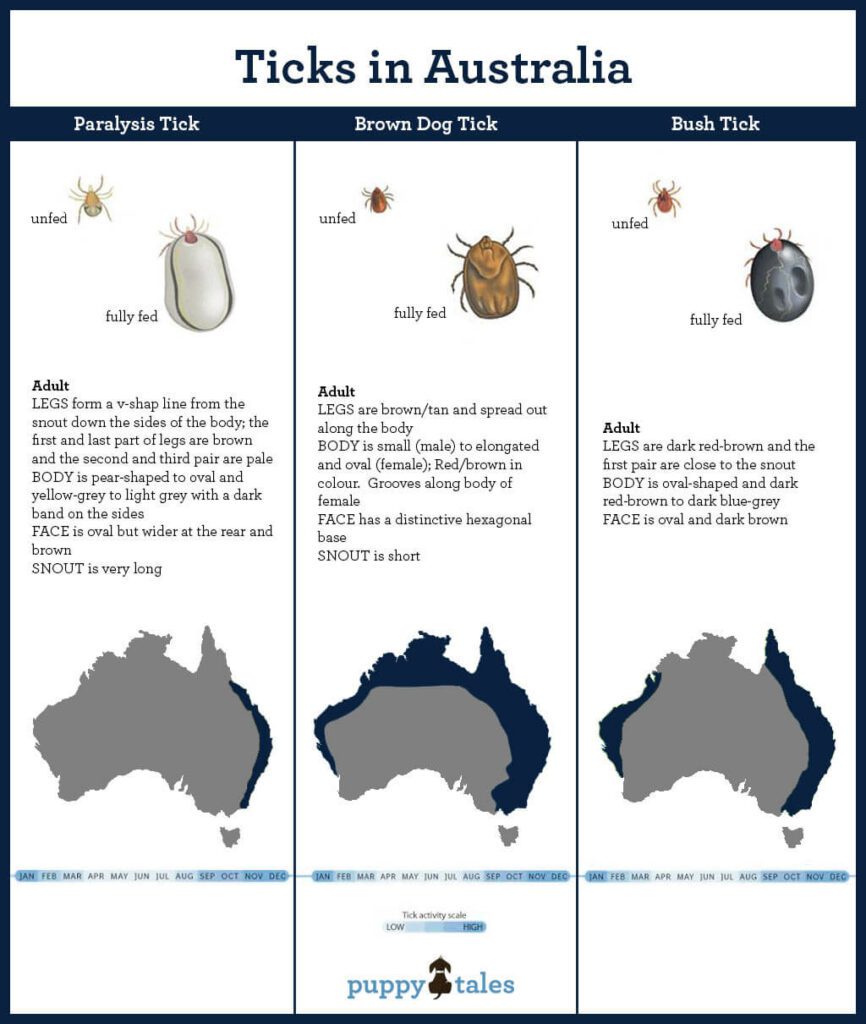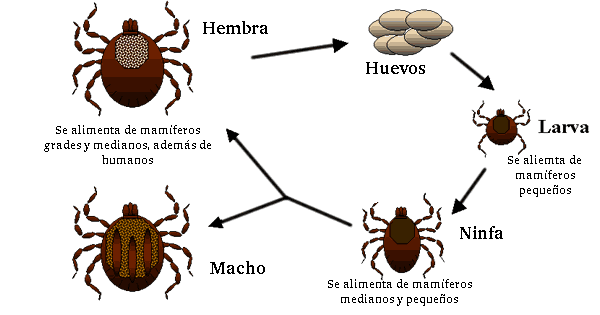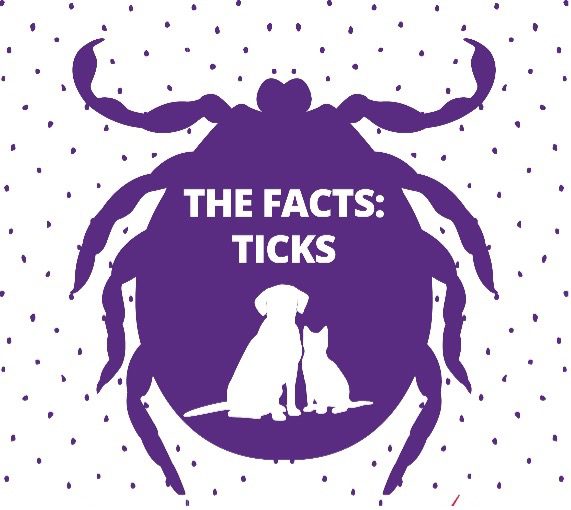As soon as you find a tick, we recommend you call us and try to bring your pet straight to The Village Vet – Pymble Clinic or Killara Hospital. We can then identify the tick, remove it, and determine if treatment is required.
Immediate removal is important if you are not able to get to the vet straight away– ideally use a tick hook, not tweezers or fingers as we don’t want to “squeeze” the tick as it is removed. If you do remove the tick then please bring it along in a container with you so we can identify what type of tick it is.
CLICK HERE FOR TO IDENTIFY PARALYSIS TICK SYMPTOMS
Read on for more information on types of ticks and the best ways to keep your pets as safe as possible.
There are many things you would share with your fur friend, but fleas and ticks are not on the list! Make sure you are set for a summer of fun by reviewing your flea and tick products now and call us if you need advice.
Ticks in Kuringai
Sydney is a hot zone for all types of ticks and Kuringai in particular is a well-known area for the Paralysis tick. Pet owners who live here know how dangerous ticks can be and it is critical that year-round protection be maintained. Statistics show us that sadly 10% of patients with tick paralysis will die from it.
There are three main types of ticks (plus Laval Ticks) that can be found in Kurringai:
1/ Paralysis Ticks
Paralysis ticks are the deadly type we hear most about. A full list of symptoms and treatments can be found here.
Sickness from the Paralysis tick (Idoxes Holocyclus) is caused by the release of holocylcic toxin into the animal. This affects the muscle function and can be fatal if treatment is not sought quickly and will be fatal if treatment is not sought at all. Our team will do everything they can to prevent any tick related fatalities however, prevention is always better than cure.
Pymble Vet sees numerous cases of Paralysis ticks every year. Spring and Summer are particularly risky times, but it is critically important to provide year-round protection for your pets.
2/ Brown Dog Tick
Although brown dog ticks do not cause tick paralysis, they can cause skin irritation and heavy infestations may result in anaemia from excessive blood loss. Brown dog ticks in other parts of Australia are known to carry the Ehrlichiosis disease. It is important to tell your vet if your pet has travelled outside of NSW if they are suffering from a tick bite.
3/ Bush Tick
If you find a bush tick on your dog, it is important to remove it. Bush ticks can cause skin irritation and can also transmit potentially fatal diseases when they bite.

4/ Laval Tick
Larval ticks are the first life stage of the paralysis tick. They jump onto the animal from a bush and cause intense irritation (chewing feet or legs or rubbing face), agitation and hyperactivity. They look like small black dots on the skin, often with surrounding redness. They can be anywhere on the body, but are most commonly seen on the feet, legs and underside of the abdomen. They are most commonly seen at the end of tick season (December onwards) but can be seen all year round. They themselves do not cause tick paralysis but are suggestive of other life stages of ticks in the area which can cause tick paralysis.
Treatment is antihistamine and steroid injections from your vet to reduce itchiness and irritation and Frontline Spray to kill the larval ticks.
Check out the appearance differences below and maybe even print off a copy of this poster to stick on your fridge at home.

Removing a Tick
Here’s how to correctly remove a tick. If you have problems or feel you have not completely removed the tick, bring them in to see us ASAP.
1/ Before you start you will need:
- Tick hook or tick twister. These can be bought at The Village Vet.
- Rubbing alcohol
- Antiseptic wipes or ointment
- Jar or other sealed container to store the removed tick.
2/ Remain Calm
The best way to keep your pet calm is for you to remain calm yourself. Unusual prodding and poking tends to make pets feel uneasy or nervous. Try to have another person assist you by gently holding your pet and keeping them relaxed.
3/ Removing the Tick
Spread your pet’s fur and hook the tick as close to the skin as possible to avoid tearing the tick.
Twist the tick in either direction and pull the tick up away from the animal’s skin.
Inspect the area to ensure the head and mouthparts are all removed. If not, take your dog to The Village Vet to have the remaining parts removed.
Use antiseptic wipes or ointment to disinfect the bite site and keep an eye on it for signs of infection. Take your pet to the vet if the bite site remains red or becomes inflamed.
4/ Dealing with the Tick
Kill the tick by placing it in the container with rubbing alcohol. Keep the tick sealed and ready to take to the vet in case your pet begins displaying symptoms of a disease.
5/ Clean up & Reward
Disinfect your hook and thoroughly wash your hands.
Reward and praise your dog and monitor them for a few days.
Tick Prevention Tips
1/ Use a Tick and Flea Prevention Treatment – YEAR ROUND!
There are multiple products for sale to combat ticks: spot-ons; sprays/ rinses; collars and tablets. The Village Vet can help you identify the right one for your pet.
Our Recommendations:
For cats: Revolution Plus monthly or Bravecto Bi monthly
For dogs: Simparica Trio monthly or Bravecto 3 monthly
Bravecto and Simparica both run rewards programs year round to save you money on repeat purchases. Check out our Offers Page for sign up links and offer details.
Added Value with The Village Vet
- Next dose reminder alert from The Village Vet when you buy from us..
- Bravecto products are guaranteed: If your pet vomits after taking a dose or the product fails we will supply you with a free replacement dose.
- If your pet suffers from a tick bite after a guaranteed dose, within coverage time, Bravecto will reimburse a percentage of veterinary treatment costs.
- If you are feeling apprehensive about administering your tick and flea medication, our nurses are always happy to apply your product or administer the dose for you. Just make an appointment and bring your pet in to see us.
Even when using a product, pets should still be checked for ticks every day, as no product can guarantee 100% protection but it is the best measure you can put in place.
2/ Daily Inspections
- Animals tend to collect ticks from pushing through grass and undergrowth so the most critical areas to check first are around the face, ears, stomach, paws and armpits. However, ticks can be found all over the body so use your finger tips to feel your pet’s coat from head to toe, taking note of any small bumps.
- Ticks can easily be missed so if you suspect your pet may have a tick they will need to be checked multiple times and should be brought to the vet.
- A soothing bath will help make your pet more comfortable when they have fleas, but won’t get rid of the problem or help with ticks.
3/ Keep Long Fur Clipped
You may wish to clip your cat or dog’s fur short if you have a long-haired breed, particularly during peak tick season. This will give the ticks fewer hiding places and helps identify itchy spots from fleas.
4/ Maintain your Pet’s Environment
- Wash your pet’s bedding and clothing in hot water to eliminate any eggs or parasites.
- Clear bushy areas in your garden where your pet may pick up ticks dropped by passing wildlife.
Check Before you Travel
If you are holidaying away from your usual spots, feel free to call our team for advice. Owners taking pets to coastal areas should start a flea and tick control product at least two weeks before leaving home, to ensure the product is working at an effective level.
Paralysis ticks are found right down the East coast of Australia and have also been found in parts of Victoria.
Sources
- Dr Martine Perkins: The Village Vet (Pymble Vet Clinic and Killara Vet Hospital)
- Bravecto 2021 Media Kit
- Zoetis 2021 Media Kit
- Northside Emergency Veterinary Services
- Vets Choice 2021 Media Kit: Article by Dr Alice Marshall, Registered Veterinarian (NSW VSB)
- RSPCA
- Puppy Tales


